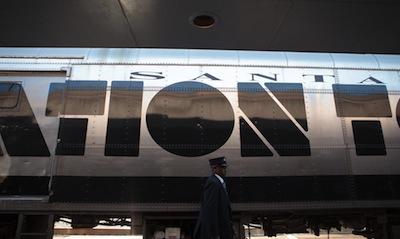Station to Station, a public-art project organized by artist Doug Aitken, has been on the road since Friday, September 6, 2013, when its first happening took place in New York. Since then, the nine-car train has passed through Pittsburgh, Chicago, Minneapolis/St. Paul, Santa Fe/Lamy, and Winslow (Arizona). The locomotive stops at Barstow before arriving at Union Station in Los Angeles this Thursday, September 26.
 Station to Station, photo by Ye Rin Mok, courtesy of Station to Station
Station to Station, photo by Ye Rin Mok, courtesy of Station to Station
Comprised of numerous components, including art installations, live music performances, culinary expositions, books (more on this on Unframed later this week), and film, Station to Station morphs (just so) as the train hosting it journeys from city to city. The project picks up artists and performers and features them during single-night performances at any given stop. For instance, Liz Glynn, whose Model Universe is one of five yurt installations on the train, was augmented with Fritz Haeg's BodyCartography Project in the Twin Cities. L.A.-based Lucky Dragons play at a singular stop: Barstow. Features change as the train moves west.
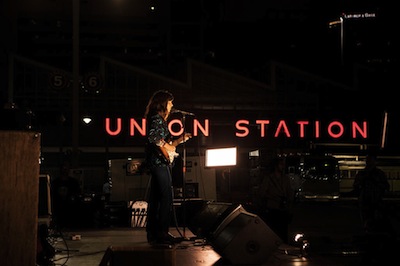 Eleanor Friedberger at the Kansas City Pop-Up Happening, photo by Mara McKevitt, courtesy of Station to Station
Eleanor Friedberger at the Kansas City Pop-Up Happening, photo by Mara McKevitt, courtesy of Station to Station
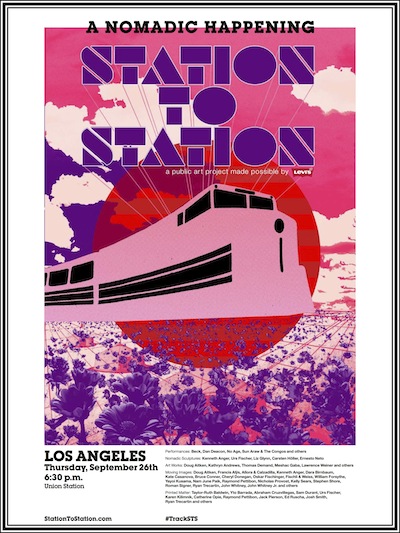 Station to Station poster for Los Angeles, courtesy of Station to Station
Station to Station poster for Los Angeles, courtesy of Station to Station
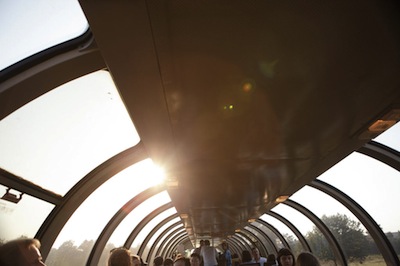 Station to Station, photo by Ye Rin Mok, courtesy of Station to Station
Station to Station, photo by Ye Rin Mok, courtesy of Station to Station
The physical mobility and conceptual portability of a project such as Station to Station begs for a look at the seemingly recent (but not so recent, as discussed later) movement of traveling art events. This phenomenon is especially interesting today, when digital media is so ubiquitous. With a network connection, anyone can "attend" an event, or be part of a movement with a simple hashtag. The notion of physical presence as a requirement seems antiquated, however, in a time when virtual encounters with art pass as authentic experiences, it is ever more important.
Recent LACMA projects make possible the physical interaction between a space or with objects. Rather than confine the museum's collection and education programs within the perimeter of the campus, LACMA has been active in expanding its offerings beyond the county of Los Angeles, of which it is a part, to reach the widest possible audience.
To quote Wired on Station to Station, "In the old world, you traveled to see the art; now it’ll travel to see you . . . "
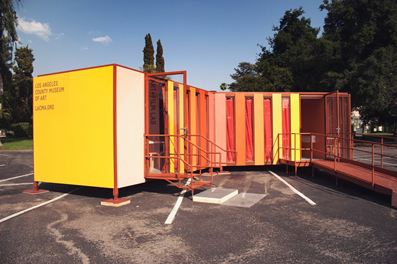 LACMA 9 Art+Film Lab, photo by Duncan Cheng
LACMA 9 Art+Film Lab, photo by Duncan Cheng
LACMA9 Art + Film Lab, which is currently in residence at the Charles White Park in Altadena, shares an ethos with Station to Station in its objective to bring to a wider audience art, film, and associated media within a contained environment. Designed by artist Jorge Pardo, the mobile structure houses a workshop for the public, featuring video making, sound recording, and oral-history documentation. LACMA staff are present to assist with creating works and to encourage open participation.
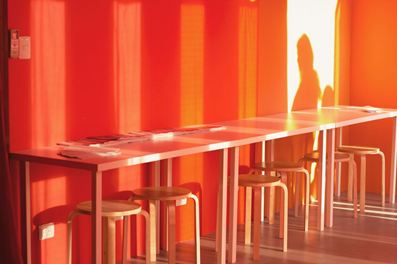 LACMA9 Art + Film Lab, photo by Duncan Cheng
LACMA9 Art + Film Lab, photo by Duncan Cheng
As Station to Station re-purposes the trafficked hubs of train stations as its temporary stage, the LACMA9 Art + Film Lab borrows public spaces, such as parks and school grounds, to plant its monthly residency. These communal spaces—accessible by all and at any time—transform into a temporary museum and performance venue. These artist-designed and appointed spaces not only render them as works of art in and of themselves, but also as places to go to and be part of. A digital interface may augment the experience, but it does not replace being there.
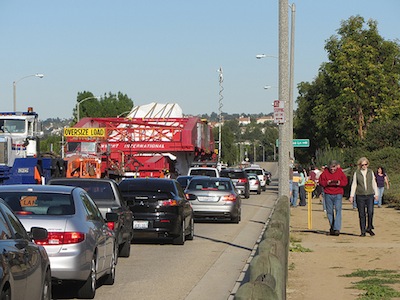 Image courtesy of waltarrrrr, via Flickr
Image courtesy of waltarrrrr, via Flickr
Just last year, LACMA's relocation of the 340-ton boulder that became the centerpiece of Michael Heizer's Levitated Mass went on the road for a little under two weeks. The boulder, which started its journey in Jurupa Valley in Riverside County, began its procession through numerous streets and parked in various neighborhoods throughout Southern California before reaching its final destination at LACMA, where it was greeted by fans who stayed up well past midnight to witness its arrival on Wilshire Boulevard.
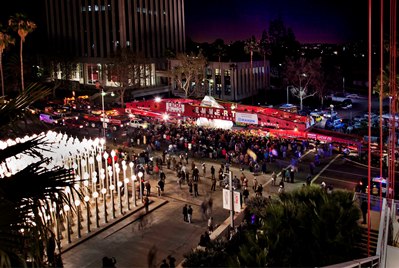 Megalith slated to become part of Michael Heizer's Levitated Mass, arriving to LACMA on March 10. Photo by Tom Vinetz, © Michael Heizer
Megalith slated to become part of Michael Heizer's Levitated Mass, arriving to LACMA on March 10. Photo by Tom Vinetz, © Michael Heizer
During its sojourn, Levitated Mass the work almost became synonymous with Levitated Mass the event. Inasmuch as the object was part of a singular work of art, the events that surrounded its relocation to LACMA were a form of ephemeral public art.
Of course, this phenomenon is certainly not specific to Station to Station or LACMA. There seems to be a sustained interest in creating spaces, although temporarily, in a time when so much interaction is not done within one.
In the end, this idea of a moving event is a novel take on the tradition of the traveling exhibition, in which works of art are transported from venue to venue in order to showcase the theses and curatorial visions that circulate within a culture. Rather than move singular works of art in crates, the crate itself becomes the exhibition. At a time when tangible experience are sometimes superseded by other options, these mobile-art projects present opportunities to be close with and part of the creation of art.
Note: Tickets to Station to Station in Los Angeles are sold out, but there will be publicly accessible art on view. Ticket sales support the Station to Station Cultural Fund, which supports programming at nine institutions, including LACMA, throughout the country. To donate to the Cultural Fund, click on this link.
Linda Theung, editor



